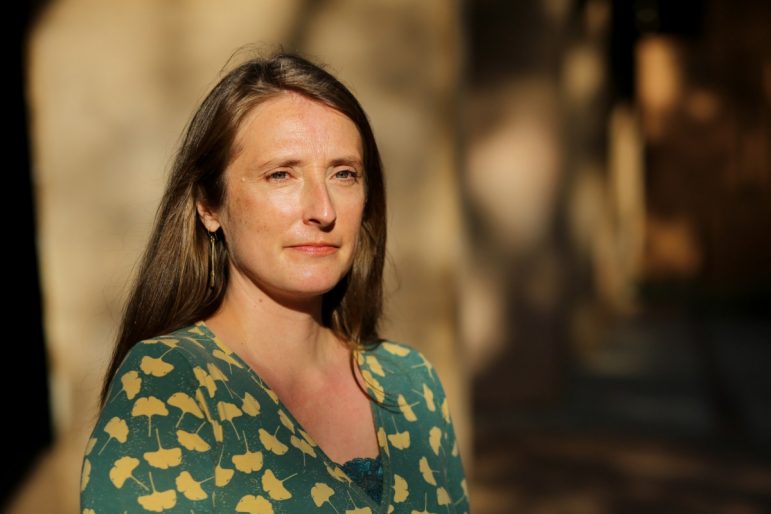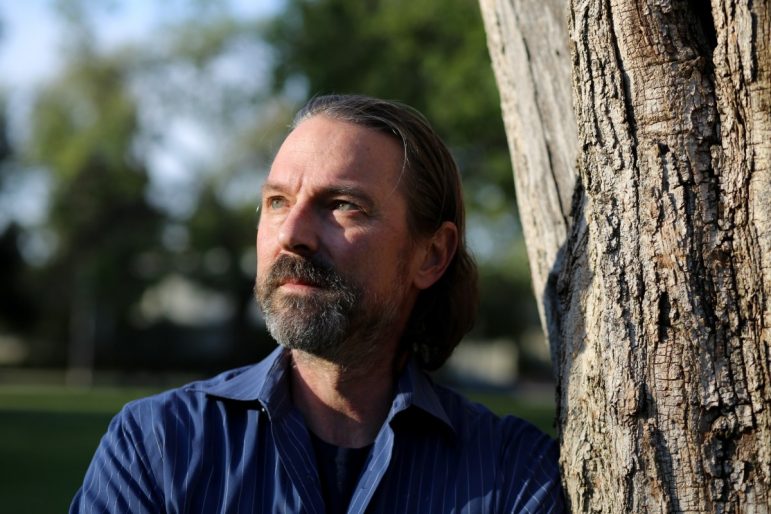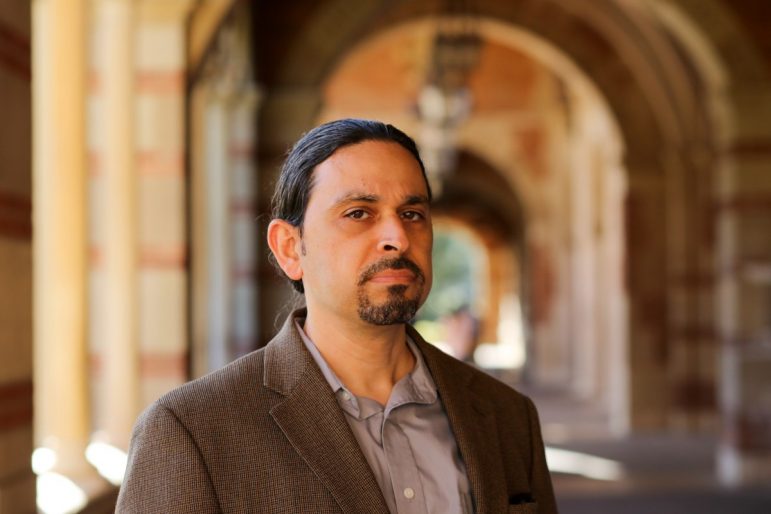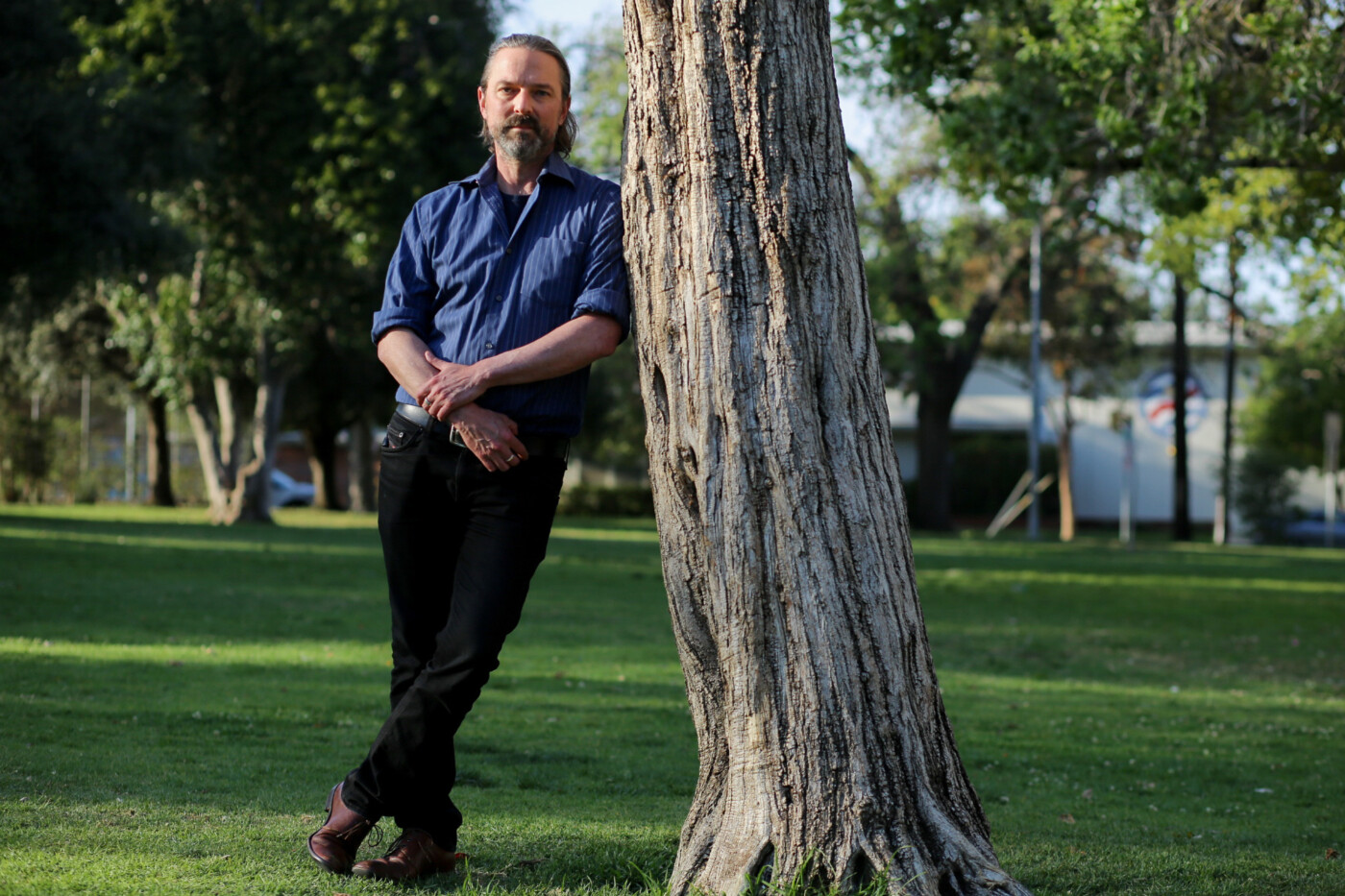Sami Siegelbaum loved teaching art history at UCLA even when his office space was a storage closet.
The pay, at around $27,000 a year for the part-time job, wasn’t great, though it was more than what he made at his teaching posts at two other colleges.
But after four years, his UCLA teaching contract wasn’t renewed in 2019 with little explanation. The university wanted to “bring in new approaches” about every three years, his department chair wrote to him, noting that the decision had nothing to do with any evaluation. In fact, Siegelbaum said no one from the department ever observed his teaching.
“I can’t overemphasize how much of a blow it was,” Siegelbaum said. It’s not just the financial hit while having one child then, now two, and living in an expensive city with his wife, a graphic designer freelancer. His identity as an academic was tied to UCLA. “It’s still a really raw wound.”
Each year, professors like Siegelbaum are one of thousands of lecturers at the University of California whose teaching contracts aren’t renewed, underscoring the paltry job security available to a vital segment that provides one-third of the instruction undergraduate students receive at the vaunted four-year public university system.
About a quarter or more of lecturers working one year disappeared from UC employment rolls the following year annually between 2015 and 2020, according to a CalMatters analysis of UC personnel data that it acquired from the university through a public records request. The findings largely mirror the lecturer union’s internal data it shared with CalMatters.
That’s a much higher rate than for other state and local education workers. Nationally, just less than a fifth separated from their jobs annually, according to federal labor statistics. But the nation’s labor force is a more volatile place overall: Among all nonfarm workers, about 42% to 45% separated from their jobs in each of the years between 2015 and 2019.
The lecturer turnover — also known as churn — in that time at the UC has been an average of about 1,440 lecturers annually and peaked at 1,618 in 2020. But paradoxically, the overall number of UC lecturers continues to grow, raising speculation among the union representing lecturers that the UC is relying on a cadre of part-time workers with few protections to educate its more than 285,000 students and keep costs low.
The figures don’t say why lecturers leave, though the lecturers’ union maintains that most aren’t re-appointed by the UC rather than leave on their own volition.
The UC refers to the churn as “alleged” in a document posted on the system’s website in March. It counters that not all lecturers want to teach regularly, citing examples of professionals such as dentists and lawyers who have full-time jobs and also lecturers who seek other employment after a couple years. It also cites budgetary changes at departments and that courses lecturers teach aren’t always recurring.
The UC declined to make anyone available to interview for this story despite multiple requests over several months.
The lecturers have had it. Over the summer the union’s members voted to allow union leadership to declare a strike. That gives the union some leverage in its negotiations with the UC president’s office in crafting a new contract. Helping the union’s efforts is support from tenured and tenure-track faculty who hold more sway in university affairs. By early October more than 400 tenured faculty had signed a petition saying they would cancel their classes in solidarity with the lecturer union if it strikes.
All told, the anger of the lecturers could lead to thousands of canceled classes affecting more than a third of undergraduates.
Lecturers occupy a tenuous position in the instructional hierarchy at the UC. Unlike tenured and tenure-track faculty who conduct research and are expected to publish scholarly papers in addition to teaching, lecturers focus on instruction and rarely have the assurances of continuous employment given to tenured faculty, who on average make three to six times more than lecturers at the UC.
Lecturers can be full time but are often part time and typically have a doctoral degree or equivalent. They mostly teach lower division and general-education courses and so are often a student’s first introduction to academic life and frequently become mentors.
That many lecturers don’t last long can leave an interpersonal hole in students’ time at the UC.
Current UC labor rules give lecturers more job stability if they work in the same department for 12 semesters or 18 quarters — the equivalent of six years — and pass an “excellence” review. Reaching that level of job security, however, can take even longer if lecturers aren’t assigned teaching positions every term or change departments. Before reaching that continuing status, lecturers can be let go for any or no reason, and generally don’t have any expectation of keeping their positions year to year. Once they get that continuing status, lecturers can still be laid off, but only with a year’s notice, buying them more time to find work elsewhere.
Lecturers are also guaranteed a 6% raise, often their first, after three cumulative years in the same department. But the average time of employment for UC lecturers is just two years, meaning many won’t qualify for that wage bump.
Said Mia McIver, a lecturer and president of UC-AFT, the union representing the UC’s more than 6,000 lecturers: “What we’re fighting for is to stop the gig-ification of the university.”

To her, the combination of lecturer turnover and prevalence of part-time work spells out a situation in which “the UC often expects us to take the pride and prestige of teaching at the University of California as part of our compensation package, which it is not.”
A spokesperson for the UC Office of the President wrote that the “UC highly values its lecturers” and this “is reflected in the fact that UC lecturers enjoy some of the best pay, benefits and working conditions in the country.”
Lecturers push back on that characterization, with many pointing out that the UC is unique in California for offering no review process for lecturers, which allows campuses to dismiss the instructors without explaining why — arguably the biggest sticking point for UC lecturers. By contrast, lecturers at Cal State University are reviewed annually, typically by department chairs.
That’s something Cal State faculty fought for, said Meghan O’Donnell, who represents lecturers in the Cal State faculty union. “Having something in writing is really helpful in us advocating for our faculty and showing that they deserve to be rehired,” she said.
Tenured faculty in solidarity with the lecturers argue that the UC’s shortchanging of lecturers is part of a “cost-cutting logic” that “starves our academic departments and programs that tells us to do more with less,” said Debbie Gould, a sociology professor at UC Santa Cruz and co-chair of the campus’s faculty association.
As the state’s third-largest employer, UC has an outsized labor role in California. For unions and workers’ rights advocates, the system can set the tone for labor issues both statewide and nationally.
Labor contract impasse
The union has been operating without a new contract since February 2020. Negotiations with the UC president’s office are at an impasse after two years of failed efforts. The UC is proposing certain pay bumps for lecturers; the union argues those raises won’t keep pace with inflation.
A key sticking point for the lecturers union is that it wants the UC to spell out what criteria it’ll use to determine whether a lecturer stays on the job or not. Currently, one doesn’t functionally exist.
“When there is no evaluation, no performance review, no in-class observation of teaching, nobody really knows ‘How are teachers teaching?’” McIver said.
The UC’s position is that if a UC campus wants to bring back a lecturer, they’ll do an evaluation.
McIver calls that “putting the cart before the horse. How do you know whether you want to reappoint someone unless you’ve already done that performance evaluation?”
Without an evaluation, lecturers don’t know why they’re being let go. The lecturer union contends that the UC is holding onto that power of ambiguity intentionally: to prevent lecturers from accumulating the semesters of service they need within a department to receive continuing appointments and the added job security that comes with it.
Lecturers have long complained that the UC relies on their temporary status as a cost-cutting tactic. It’s partly why lecturers went on strike in 2002, when a union leader said the UC operates like “drivers in pick-up trucks who pick up day laborers and pay them for one day and then never see them again.”
The result of that work stoppage was the “continuing lecturer” status that gave some lecturers an indefinite teaching appointment.
The UC doesn’t use terms like cost-cutting, but argued in 2002 that lecturers are an inherently temporary position to meet the teaching needs of the campuses. UC literature today makes similar references to the need for flexibility with lecturer hires, saying some don’t come back because of “academic programmatic or budgetary changes within a department.”
Regardless, the UC has increasingly relied on their work to teach classes. Since 2011, the number of lecturers at the UC has risen by 41% while faculty on the permanent track have risen just 19%.
The UC maintains that it provides generous job stability to lecturers, saying that it’s one of two universities in the U.S. where lecturers can continue their appointment indefinitely once they clear that six-year threshold to receive continuing appointments.
But union data suggests there’s scant hope of continuous employment: About 1,200 of the more than 6,300 lecturers in 2019-20 had continuing status (the data CalMatters obtained through a public records request doesn’t contain continuing lecturer status).
McIver has continuing status now, but it took her 11 years, not six. Initially she taught at UC Irvine for five years, getting 75% of full-time work. When a full-time position at UCLA opened up for the same job in an identical department, she took it, but surrendered her service credit toward continuing status and started all over. Even changing departments within the same university restarts the clock on continuing status.
National comparisons for lecturer churn are virtually non-existent. When CalMatters shared the UC churn data findings with Adrianna Kezar, a leading scholar on faculty labor dynamics at the University of Southern California, she said the numbers are evidence of a lecturer turnover crisis that isn’t getting enough attention.
“I think you’re articulating something that people aren’t even recognizing as a crisis, which I think is important,” Kezar said. “I don’t hear people talking enough about the churn issue.”
Few job protections
The pursuit of stable academic work often requires lecturers to hustle, “but then it turns out that there is no tenure track position available,” Siegelbaum said, leaving the lecturer “clinging to these gigs that you have.” Other lecturers spoke of maintaining relationships with department chairs to continue receiving teaching work, made more challenging whenever a new chair emerges.
During his first year lecturing at UCLA, Siegelbaum would teach two classes back-to-back at Loyola Marymount University and then have an hour to crawl along the 405 freeway in his car before the start of his three-hour course at UCLA.
“You’ve entered this track and rut and it’s not easy to make moves to a different industry or career or sector,” Siegelbaum said.
He now teaches at three colleges, none a UC, while seeking arbitration with UCLA after he and the union filed a grievance saying he was wrongfully dismissed. But because lecturers had weak job protections to begin with, he said the union wasn’t hopeful a ruling would land in his favor.
Five years after earning his Ph.D in sociology in 2008, Michael Calderon-Zaks quit teaching altogether because he couldn’t land a university job at either a UC or California State University that lasted longer than a single term in Northern California. He moved to Los Angeles to attend a master’s program in urban planning, but left it after two terms because he got a job teaching at a community college near Los Angeles. That led to more work, ultimately resulting in lecturer positions at UC Irvine, UCLA and now UC San Diego where he’s starting his fourth year of teaching. At 46, “it’s only in the last five years that I’ve had some stability,” said Calderon-Zaks, who’s taught at six UCs.
It’s not uncommon for lecturers to learn they’ll be invited to teach again a month or less before fall of the new academic year begins, even though the union contract with the UC asks that campuses do so by or around June 1.

David Walter was even once hired a week into the semester at Berkeley. Just before the start of this academic year he got notice to teach for two departments this fall, going from unemployed to beyond full-time in a flash. “One of the things you have to show the department is that you’re capable of working fast to put a class together,” said the professor of literature, who is also a local union representative. He’s still unsure if he’ll be asked to teach this spring, though.
Preserving more lecturers has equity implications, too. Lecturers are more likely to be women and people of color. While 65% of tenured faculty were white, the same was true for just 57% of lecturers in 2020. Two-thirds of tenured faculty were men in 2019; more than half of lecturers were women. Pervasive part-time appointments for lecturers often mean moonlighting shifts at other colleges or gig work. UC’s lecturers each earn $32,000 per year, according to a CalMatters analysis of UC wage data through a public records request, in part because so many are given part-time assignments.
Calderon’s main source of work, UC San Diego, didn’t offer him a winter position last academic year, so he received jobless benefits until spring quarter began. Walter, without enough lecturing positions at Berkeley to feel financially steady, is trying to sell payment processing systems to restaurants in San Francisco. He’d rather be a continuing lecturer, something that grants a reasonable assurance of stability and pays enough to dedicate time to writing book reviews or other scholarly tasks.
The effect on undergraduate students
For students, the revolving door of lecturers upends valuable relations they’ve developed with educators who’ve inspired or mentored them in one year only to be gone completely the next.

“It’s weird to get letters of recommendation from students and places I no longer teach at,” Calderon-Zaks said. Early this year a student from UCLA asked Calderon-Zaks to write her a letter of recommendation, even though he hasn’t taught there since last spring. “We have no security to show for it and, of course, the irony is that we’re still being asked even though we’re no longer there.”
Decades of research show that the more students interact with faculty, the more they gain from their college educations.
“It’s incredibly problematic if the faculty are not there to develop these relationships,” said Kezar, the USC professor, in an interview. She co-wrote a paper on the effect faculty churn can have on student academics.
Chase Hobbs-Morgan, a political science lecturer at UC Santa Barbara, told the UC Regents in September how they commit a lot of their personal time to mentoring struggling students. But “because I never know when my job will expire, I can’t credibly tell I’ll be able to support them down the line,” Hobbs-Morgan said.
That would have been bad news for Esmeralda Quintero-Cubillan, a senior at UC Santa Barbara and president of the UC Student Association, who has taken Morgan’s classes several times and credits them with helping her feel more welcomed as a UC student who can academically thrive.
In an interview, she spoke fondly of how Morgan parked themselves outside a campus cafe during finals week for several hours so that students could write their papers and ask questions.
Lecturers tend to teach her favorite courses, said Quintero-Cubillan. While tenured professors focus on research, it’s the lecturers, by virtue of focusing just on teaching, whose instruction she appreciates more. Lecturers “are usually more dedicated to our lived experiences and our actual learning,” she said.
It wasn’t always like this
Faculty turnover wasn’t always a feature of universities, in large part because most university professors were full time and tenured. Until the early 1980s, “we didn’t have churn; faculty tended to stay at their campuses for most of their career,” said Kezar, the USC researcher.
But a combination of state spending cuts and increased reliance on part-time faculty slowly chipped away at that standard nationally, leading to a situation where nationally 45% of faculty were tenured or tenure-track at universities and colleges with doctoral programs in fall 2018, down from 51% a decade earlier.
Comparable figures for the UC are difficult to determine, but a researcher at the American Association of University Professors crunched federal data for CalMatters, showing that among full-time faculty, 61% were tenured or on the tenure track in fall 2018, down from 67% a decade earlier.
California’s diminishing investment in higher education may also be a factor in fewer tenure opportunities. At the turn of the millennium, the state budget gave the UC about $28,000 per student. In 2018, it was half that, around $13,500.
In 1980, higher-education spending far dwarfed prison spending in California, receiving five times more in state dollars. Though higher education now still receives more from the general fund, state corrections gets comparatively much more than it did before: Last year, higher education received $17.9 billion while corrections got $12.4 billion.
Not all lecturers have a tortuous time reaching continuing lecturer status. Charlotte Smith, a continuing lecturer at Berkeley’s school of public health, said her experience is how it should be for every lecturer. She was able to stay at the same department for six years before reaching continuing service. “I didn’t have that fear or that uncertainty,” she said. “I had confidence that every year that I would be brought back.”
Possible strike and looking ahead
There are steps to take before thousands of lecturers walk off the job.
The two sides are now in state-led mediation through the California Public Employment Relations Board. If mediation doesn’t lead to both parties agreeing on a contract, state law allows either side to call for the creation of a fact-finding panel that can issue non-binding solutions. The UC Board of Regents, which oversees the UC system, then may have to vote publicly on whether to adopt those recommendations.
If it comes down to a decision by the Regents, expect fireworks. Several tenured faculty called during the July and September meetings to voice their solidarity with the union even though their jobs are secure.
Harold Marcuse, a history professor at UC Santa Barbara, said longer contracts for lecturers means less headache for administrative faculty in searching for new lecturers: “Once we have found them, we want to keep them, and keep them happy.”
John Osborn D’Agostino contributed to this story.
